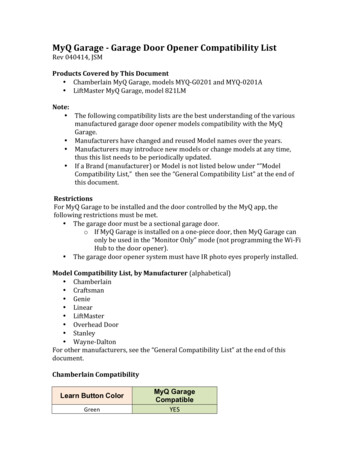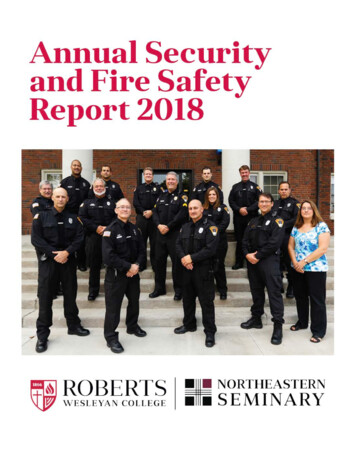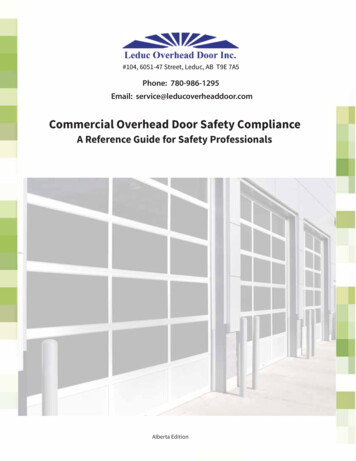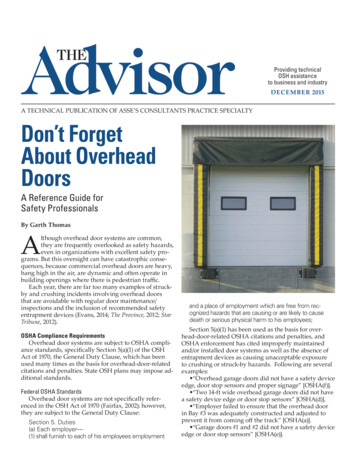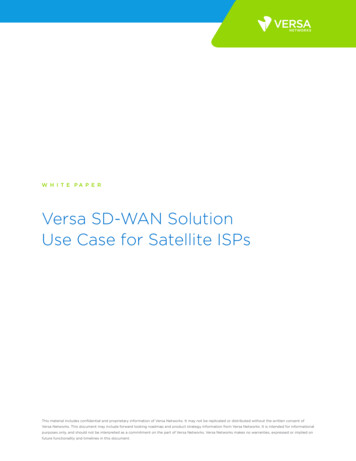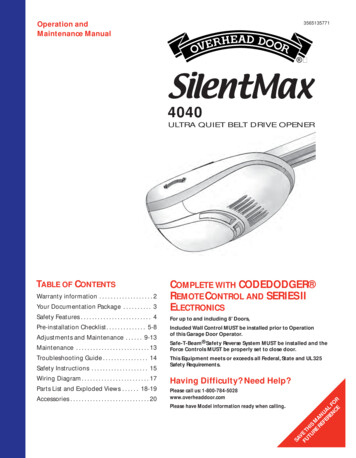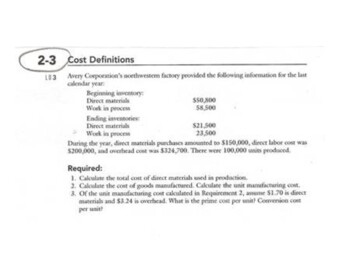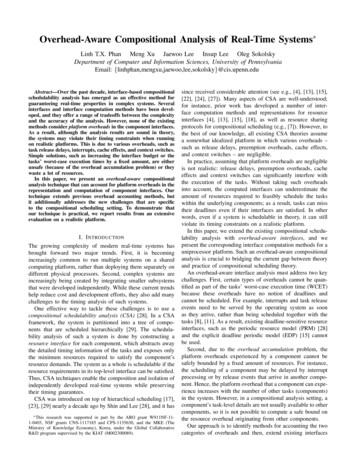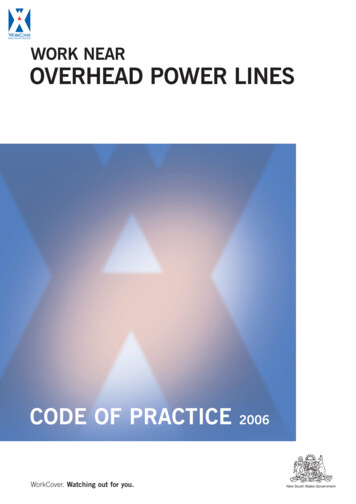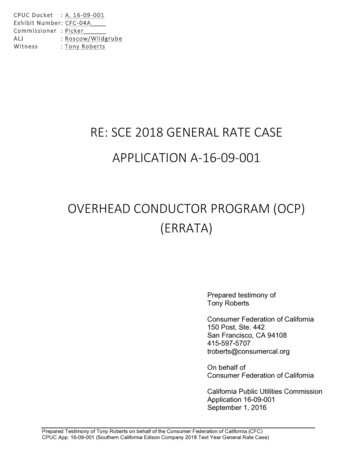
Transcription
CPUC D oc ket :Exh ibit Nu mbe r:Co mmis sio n er :A LJ:Witn es s:A . 16 -09 -001CFC -04APicke rRo s co w/ Wild gru b eTo ny Ro b ertsRE: SCE 2018 GENERAL RATE CASEAPPLICATION A-16-09-001OVERHEAD CONDUCTOR PROGRAM (OCP)(ERRATA)Prepared testimony ofTony RobertsConsumer Federation of California150 Post, Ste. 442San Francisco, CA 94108415-597-5707troberts@consumercal.orgOn behalf ofConsumer Federation of CaliforniaCalifornia Public Utilities CommissionApplication 16-09-001September 1, 2016Prepared Testimony of Tony Roberts on behalf of the Consumer Federation of California (CFC)CPUC App. 16-09-001 (Southern California Edison Company 2018 Test Year General Rate Case)
12345678910WITNESS QUALIFICATIONSThis testimony is presented by Tony Roberts, Regulatory Specialist, on behalf ofConsumer Federation of California (CFC). Mr. Roberts has 20 years of experience inenergy and transportation issues. He served for four years as a Senior Economistwith the British Columbia Utilities Commission. He has been an economics andpolicy consultant for consumer interest advocacy groups in regulatory proceedings inCanada for five years. Mr. Roberts is a member of the Association of ProfessionalEconomists of British Columbia, and the Chartered Institute of Logistics andTransportation. His qualifications are attached.11I.12OVERHEAD CONDUCTOR PROGRAM (OCP)A. GRC APPLICATION131415161. SCE proposes a budget of 139.5 million (in 2018) for funding theOverhead Conductor Program (OCP). The proposed test yearexpenditures are 143.9 million and 148.5 million, respectively.11718192. The OCP covers the cost of replacing existing small-gauge conductorwith larger conductor, consistent with current standards,2 as well asother, associated equipment upgrades.20B. CFC PROPOSAL2122232425261. CFC proposes limiting the OCP program expenditure to 116.3 million,for 2018. For the post-test years, CFC recommends expenditures of 123.0 million (2019) and 130.0 million (2020). Theserecommendations would reduce the OCP expenditure by 23.3 millionfor 2018, 20.9 million for 2019, and 18.5 million for 2020.272829302. CFC’s recommendation is based on the approach SCE proposed forcapital expenditures, wherein the company suggests escalating units aswell as unit costs. CFC considers such an approach suitable for OCP,due to the very long term nature of the program.12SCE02V08, Table III-12, p.49.SCE02V02, p.23, Figure II-12.Prepared Testimony of Tony Roberts on behalf of the Consumer Federation of California (CFC) CPUCApp. 16-09-001 (Southern California Edison Company 2018 Test Year General Rate Case)Page 1
12345678910C. PROGRAM DESCRIPTION1. SCE describes the goals of the Overhead Conductor Program (OCP) asreducing the frequency and impact of wire down events throughproactive overhead conductor replacements, and reactive conductorreplacements carried out as part of remedying wire down emergencies.3Associated circuit protection devices (e.g., reclosers) are also replacedor upgraded, as part of OCP. The company says OCP is one of its “mostimportant safety programs launched in recent years.”41112132. OCP replaces small gauge conductor, appropriate to the standards whenit was originally installed, with greater capacity conductor. As of 2014,SCE had 16,000 circuit miles of small conductor.514153. OCP prioritizes candidate overhead circuits by examining the likelihoodof wire down events, and the associated safety and reliability risks.61617181920214. OCP was initiated in 20157. In 2015, SCE spent 58.1 million on OCP.8The planned expenditures will reach 139.5 million per year, in 2018.9The expenditure level is associated with SCE executing 300 circuit milesper year. Over time, the annual OCP expenditure will increase due tounit cost inflation, with the volume of work (the annual circuit miles beingreplaced) remaining constant. At 300 circuit-miles per year, it will take3SCE02V08, p.47SCE01, p.115TURN-SCE-016, Q4a.6SCE01, p.11.7SCE02V08, p.478SCE02V08, Table III-12, p.499Id.4Prepared Testimony of Tony Roberts on behalf of the Consumer Federation of California (CFC) CPUCApp. 16-09-001 (Southern California Edison Company 2018 Test Year General Rate Case)Page 2
53 years to make all the required replacements.101D. EXPECTED PROGRAM BENEFITS21. OCP is intended to reduce the frequency and impact of wire downevents. In describing the program, SCE emphasizes the relationshipbetween short circuit duty (SCD) and its potential to both damageoverhead conductors and potentially lead to conductor failure.Conductors may fail in place, leading to outages, or fail catastrophically,leading to wires down, with the potential for electrocutions.113456782. For measuring OCP program benefits, “SCE plans to compare wire downdata prior to the project and after the project. The impacts will bemeasured at the circuit level because the projects and other dataavailable are at a circuit level. In addition, SCE plans to evaluate theSAIDI and SAIFI impacts on the overall system.”1291011121314E. EXPECTED PROGRAM COSTS151. Figure III-17 of exhibit SCE02V08 illustrates the proposed spending for1610TURN-SCE-016, Q4a.SCE02V08, pp. 47,51.12CFC-SCE-002,Q9b.11Prepared Testimony of Tony Roberts on behalf of the Consumer Federation of California (CFC) CPUCApp. 16-09-001 (Southern California Edison Company 2018 Test Year General Rate Case)Page 3
OCP. 13 .122. From zero expenditure in 2014, OCP spending emerged at 58.1 million,in 2015.14 For 2016, intended to spend 142.2 million on OCP, and afurther 136.1 million, in 2017. For the GRC term, SCE proposes annualexpenditures of 139.5 million (in 2018 dollars).1534567F. ANALYSIS OF SAFETY VS. RELIABILITY IMPACTS8910111. SCE introduces OCP as a new program aimed at addressing publicsafety risks.16 However, OCPs anticipated reliability impacts appear toaccount for a significant portion of overall expected benefits.17121314151617182. Although SCE anticipates both safety and reliability benefits from OCP,the company has not formally quantified the split between both impacts.SCE is “ not able to track what portion of OCP expenditures addresssafety vs. reliability risk as the same work addresses both.”18 AlthoughSCE emphasizes the safety benefit of OCP, the lone metrics thecompany apparently intends to apply for program performanceevaluation are SAIDI and SAIFI—standard reliability metrics.19202122233. As public interest advocates, CFC endorses SCE taking action toimprove safety. As consumer advocates, CFC supports utilityinvestments intended to improve service quality. Reliabilityimprovements benefit customers, and so the associated investments arewelcome.242526274. Absent a specific attribution of OCP expenditures between safety andreliability, it would be reasonable to assume the benefits are evenly splitbetween the two. If so, assuming 300 circuit miles per year were beingre-conductored under each objective would be reasonable. Alternatively,13SCE02V08, p.50.SCE02V08, Table III-12, p.49.15Id.16SCE02V08, p.47.17SCE02V08, pp.47-49.18CFC-SCE-002,Q6e.14Prepared Testimony of Tony Roberts on behalf of the Consumer Federation of California (CFC) CPUCApp. 16-09-001 (Southern California Edison Company 2018 Test Year General Rate Case)Page 4
12assuming safety is the primary purpose, it could be assumed that 200miles are for safety, with 100 for reliability.3456785. Not only can reliability be quantified, the distribution of benefits can beestimated, based on customer valuations of service. The differentialvaluations by customer class are well documented. Reliabilityimprovements (or, avoided reliability decreases) are broadly morebeneficial for commercial and industrial customers, than residentialcustomers.199106. In prioritizing OCP projects, SCE is currently counting customers equally,regardless of type or size.20 As SCE recognizes,111213141516“ with all other factors being equal (including circuit loading) andassuming the typical residential customer load is less than that of anonresidential customer load on a given circuit, then circuits with ahigher proportion of residential customers to nonresidentialcustomers will tend to be prioritized over circuits with a lowerproportion of residential customers to nonresidential customers.”211718192021222324252627287. Nevertheless, in safety terms, locales with a higher proportion ofresidential customers are likely also (relatively) population dense. If so,reducing wire down events means less potential exposure of the publicto electrocution hazard. This dimension of OCP would be bettersupported, had SCE quantified the specific value of avoided potentialcost. Instead, the company describes proposed OCP spending hashaving been determined on the basis of addressing safety and reliabilityat “reasonable cost.”22 Unlike the As Low As Reasonably Practicable(ALARP) method, that requires declaring a valuation of saved life (VSL),SCE’s RSE approach does not include quantifying the benefit of lifesaved.23 For this reason, it is not clear whether the OCP expendituresproposed for the 2018 GRC term are optimal.19Brattle Group, “Electric Reliability, Resiliency, Rates and Region,” presentation to EdisonElectric Institute, Transmission, Distribution, and Metering Conference, Oct. 7,2013, Slide #13.20CFC-SCE-002, Q15b.21CFC-SCE-006, Q10a.22CFC-SCE-002, Q10.23A.15-05-002, “Comments of San Diego Gas & Electric Company, Southern California GasCompany, Pacific Gas and Electric Company, and Southern California Edison Company onEvaluation Report Prepared by Safety and Enforcement Division,” p.7.Prepared Testimony of Tony Roberts on behalf of the Consumer Federation of California (CFC) CPUCApp. 16-09-001 (Southern California Edison Company 2018 Test Year General Rate Case)Page 5
8. SCE indicates that customer interruption cost estimates do not play arole in prioritizing OCP circuits.24 This is indeed unfortunate, as reducedoutage frequencies (SAIFI) and durations (SAIDI) are the programperformance metrics, and account for a good portion of the benefits OCPwill produce, and that will be directly realized by the affected customers.Ideally, OCP prioritization would reflect the service quality value gainedby affected customers in the form of avoided outages.12345678910111213149. OCP will improve the ability of the SCE system to accommodateDERs.25,26 The transient loads associated with DERs can causeconductors that would otherwise be adequate to become overloaded.CFC notes the coincidence between the growth of DERs, and theemergence of OCP. However, SCE says “Proactive projects are notcaused by interconnecting new generation, accommodating new largemotor loads, secular load growth, or increased load variations.”27151617181910. SCE points to the need for the system to accommodate short circuit duty(SCD), and the growing problem that SCD represents.28 Increased SCDrequirements have presumably been mounting apace over time.Therefore, a sudden need to address the problem seems surprising—ifnot counter-intuitive.202122232411. SCE explains that many of the network conductors were installed longago, when standards allowed less robust equipment.29 Certainly bothstandards (particularly General Order 95 (GO 95)) have changed overtime. However, the original designs may have underestimated theeventual load growth.25262728293012. Certainly, increased SCD considerations mean what had been adequateconductor capacity when installed, may well no longer be the case.However, the increased loads are not in and of themselves sufficientreason for replacement, per se. While reactive conductor replacementsare certainly justifiable, whether all proposed proactive replacements are,is less clear.24CFC-SCE-005, Q11a.Navigant, “Distributed Generation Integration Cost Study,” 2013, p.23.26SCE “The Impact of Localized Energy Resources on Southern California Edison’sTransmission and Distribution System,” May 2012, pp.11,20,21,23.27CFC-SCE-005, Q15a.28CFC-SCE-006, Q1a.29SCE02V08, p.48.25Prepared Testimony of Tony Roberts on behalf of the Consumer Federation of California (CFC) CPUCApp. 16-09-001 (Southern California Edison Company 2018 Test Year General Rate Case)Page 6
13. CFC appreciates, and agrees with, the long-term need to replaceconductor. The questions are in regard to timing and who should pay.Cost causation appears to militate in favor of differential recovery fromcustomer classes. However, as benefit quantification is not available atthis stage, figuring out exactly who should pay for what, and in whatproportions, makes the appropriate incidence of that recovery uncertain.123456G. CONTRAST WITH WCR PROGRAM789101. SCE presents OCP in a quite contrasting fashion to WCR program. Thecompany clearly demonstrates how WCR is quantitatively-based, usingstandard cost-benefit evaluation techniques.111213141516172. SCE acknowledges that, compared to WCR, OCP is in its early stage ofdevelopment. “OCP started scoping and executing work in 2015 toaddress these safety risks. SCE has refined its scoping criteria forproactive OCP projects and has identified work for 2016 and 2017. Asoverhead conductor risk analysis continues to be refined, the scopingcriteria and mix of mitigations targeted for the OCP will continue toevolve.”3018193. The company describes its intentions to improve infrastructurereplacement decisions going forward:The effectiveness of replacement decisions will improve asadditional data becomes available and more sophisticatedprobabilistic models are developed. SCE’s understanding of riskdrivers and mitigation alternatives related to overhead conductorhas significantly improved in recent years. This greaterunderstanding has helped SCE improve its Overhead ConductorProgram “OCP” scope selection processes, which is expected toincrease the effectiveness of OCP in reducing identified risks. Forall assets in the IR program, SCE is committed to the continuousimprovement of replacement decision analytics to achieve desiredsafety and reliability goals with maximum customer benefit.312021222324252627282930Regarding the additional data and models that will improve OCP:313031SCE02V08, p.47.SCE02V08, p.12.Prepared Testimony of Tony Roberts on behalf of the Consumer Federation of California (CFC) CPUCApp. 16-09-001 (Southern California Edison Company 2018 Test Year General Rate Case)Page 7
“Additional data” in this context refers to either adding data, such asa proxy for conductor age, or extending the time series for the datafields already used in this model, like updating the wire downevents by circuit. Developing “more sophisticated models” refers tomodeling risk at a more granular asset level than by circuit. Thesemodeling improvements have been discussed as next steps in OCPrisk analysis, however there is not a timeline in place to completethis work.”3212345678Lastly, the following SCE comment seems indicative of the work-inprogress nature of OCP:910As the specific circuits in scope for 2018 have not yet beenselected, we have not calculated the expected reduction in riskassociated with our proposal of upgrading 300 miles of distributionoverhead conductor and installing branch line fuses in 2018. In thefuture, when the forecast portfolio specifies the type and scope ofmitigation by tranche, we will be able to forecast the expectedreduction in risk and RSE for the proposed programs and/orprojects.33111213141516171819H. RECOMMENDATIONS2021222324251. OCP should be approved, but the expenditure amounts for the 2018GRC term should be reduced. Based on SCE’s stated intentionsregarding expected quantitative improvements to the OCP selection andevaluation processes, it appears that the undertakings during the 2018GRC term are still part of a pioneering phase.2627282930312. SCE has proposed capital unit escalations, in addition to unit costescalation.34 As the company points out, under such an approach, SCE“ will be able to undertake more projects or larger projects each year inorder to improve service to its customers and provide new gridcapabilities in a safe and reliable manner.”35 CFC considers that OCPshould also be undertaken in this manner. CFC calculates that if OCP32CFC-SCE-002, Q19a.SCE-14, p.51.34SCE09V01, p.121.35CFC-SCE-001, Q.11a.33Prepared Testimony of Tony Roberts on behalf of the Consumer Federation of California (CFC) CPUCApp. 16-09-001 (Southern California Edison Company 2018 Test Year General Rate Case)Page 8
12345undertook 250 miles in 2018, and escalated the miles at 2.5 percenteach year to 202936 (at which time, the annual replacement miles wouldreach roughly 330), the replacements would be completed in 49 years—as opposed to the application’s proposed 53 years, based on replacing aconstant 300 miles per year.678910113. CFC proposes 250 miles as a starting point because it comports withtaking the perspective that the majority OCP program objective is safety:2/3 for safety and 1/3 for reliability. On that basis, the “safety miles” are200 per year, and the remaining 100 are for reliability. CFCrecommends doing all the safety miles, and 50% of “reliability miles” (so,50 miles per year, being half the residual 100 miles).1213141516174. CFC proposes limiting the OCP program expenditure to 116.3 million,for 2018. For the post-test years, CFC recommends expenditures of 123.0 million (2019) and 130.0 million (2020). Theserecommendations would reduce the OCP expenditure by 23.3 millionfor 2018, 20.9 million for 2019, and 18.5 million for 2020.181920215. SCE expects replacing all small conductors to take 53 years. Due to thelong-term nature of the program, a strategic spending plan is required.The current proposed pattern of expenditures does not reflect a longterm, strategic treatment of the program--and its funding.36The miles would be escalated at 2.5% per year, to 2029; from 2029 onward, SCE wouldreplace 328 miles per year.Prepared Testimony of Tony Roberts on behalf of the Consumer Federation of California (CFC) CPUCApp. 16-09-001 (Southern California Edison Company 2018 Test Year General Rate Case)Page 9
6. Due to the very long term timeframe for the program, CFC believes someconsideration be given to using an OCP rate rider to specifically fund there-conductoring. The rider ideally would reflect the class-specificbenefits anticipated from OCP. As SCE plans to evaluate OCP impactsat the circuit level, specific cost attribution to benefitting customers will bepossible.37 Rather than leaving funding for such program to potentialvagaries of the broader GRC process, it would be better toinstitutionalize the provision of the needed funds. It also gives clarity forfuture OCP funding adjustments, as periodic (i.e., GRC cycle) reviews ofthe costs and benefits would affect the rider.1234567891037CFC-SCE-002, Q.9b.Prepared Testimony of Tony Roberts on behalf of the Consumer Federation of California (CFC) CPUCApp. 16-09-001 (Southern California Edison Company 2018 Test Year General Rate Case)Page 10
Attachment: 1TURN-SCE-016,Q4aPrepared Testimony of Tony Roberts on behalf of the Consumer Federation of California (CFC) CPUCApp. 16-09-001 (Southern California Edison Company 2018 Test Year General Rate Case)Page 11
Attachment: 2CFC-SCE-002,Q9bPrepared Testimony of Tony Roberts on behalf of the Consumer Federation of California (CFC) CPUCApp. 16-09-001 (Southern California Edison Company 2018 Test Year General Rate Case)Page 12
Attachment: 3Brattle Group, “Electric Reliability, Resiliency, Rates and Region,” presentation toEdison Electric Institute, Transmission, Distribution, and Metering Conference,Oct. 7,2013, Slide #13Prepared Testimony of Tony Roberts on behalf of the Consumer Federation of California (CFC) CPUCApp. 16-09-001 (Southern California Edison Company 2018 Test Year General Rate Case)Page 13
Attachment: 4CFC-SCE-002,Q15bPrepared Testimony of Tony Roberts on behalf of the Consumer Federation of California (CFC) CPUCApp. 16-09-001 (Southern California Edison Company 2018 Test Year General Rate Case)Page 14
Attachment: 5CFC-SCE-005,Q10aPrepared Testimony of Tony Roberts on behalf of the Consumer Federation of California (CFC) CPUCApp. 16-09-001 (Southern California Edison Company 2018 Test Year General Rate Case)Page 15
Attachment: 6CFC-SCE-002,Q10.Prepared Testimony of Tony Roberts on behalf of the Consumer Federation of California (CFC) CPUCApp. 16-09-001 (Southern California Edison Company 2018 Test Year General Rate Case)Page 16
Attachment: 7Navigant, “Distributed Generation Integration Cost Study,” 2013, p.23.Prepared Testimony of Tony Roberts on behalf of the Consumer Federation of California (CFC) CPUCApp. 16-09-001 (Southern California Edison Company 2018 Test Year General Rate Case)Page 17
Attachment: 8Navigant, “Distributed Generation Integration Cost Study,” 2013, p.48Prepared Testimony of Tony Roberts on behalf of the Consumer Federation of California (CFC) CPUCApp. 16-09-001 (Southern California Edison Company 2018 Test Year General Rate Case)Page 18
Attachment: 9SCE “The Impact of Localized Energy Resources on Southern California Edison’sTransmission and Distribution System,” May 2012, p.11Prepared Testimony of Tony Roberts on behalf of the Consumer Federation of California (CFC) CPUCApp. 16-09-001 (Southern California Edison Company 2018 Test Year General Rate Case)Page 19
Attachment: 10SCE “The Impact of Localized Energy Resources on Southern California Edison’sTransmission and Distribution System,” May 2012, p.20Prepared Testimony of Tony Roberts on behalf of the Consumer Federation of California (CFC) CPUCApp. 16-09-001 (Southern California Edison Company 2018 Test Year General Rate Case)Page 20
Attachment: 11SCE “The Impact of Localized Energy Resources on Southern California Edison’sTransmission and Distribution System,” May 2012, p.21Prepared Testimony of Tony Roberts on behalf of the Consumer Federation of California (CFC) CPUCApp. 16-09-001 (Southern California Edison Company 2018 Test Year General Rate Case)Page 21
Attachment: 12SCE “The Impact of Localized Energy Resources on Southern California Edison’sTransmission and Distribution System,” May 2012, p. 23Prepared Testimony of Tony Roberts on behalf of the Consumer Federation of California (CFC) CPUCApp. 16-09-001 (Southern California Edison Company 2018 Test Year General Rate Case)Page 22
Attachment: 13CFC-SCE-005,Q15aPrepared Testimony of Tony Roberts on behalf of the Consumer Federation of California (CFC) CPUCApp. 16-09-001 (Southern California Edison Company 2018 Test Year General Rate Case)Page 23
Attachment: 14CFC-SCE-005,Q16e.Prepared Testimony of Tony Roberts on behalf of the Consumer Federation of California (CFC) CPUCApp. 16-09-001 (Southern California Edison Company 2018 Test Year General Rate Case)Page 24
Attachment: 15CFC-SCE-005,Q11aPrepared Testimony of Tony Roberts on behalf of the Consumer Federation of California (CFC) CPUCApp. 16-09-001 (Southern California Edison Company 2018 Test Year General Rate Case)Page 25
Attachment: 16CFC-SCE-001,Q11aPrepared Testimony of Tony Roberts on behalf of the Consumer Federation of California (CFC) CPUCApp. 16-09-001 (Southern California Edison Company 2018 Test Year General Rate Case)Page 26
Attachment: 17CFC-SCE-002,Q9bPrepared Testimony of Tony Roberts on behalf of the Consumer Federation of California (CFC) CPUCApp. 16-09-001 (Southern California Edison Company 2018 Test Year General Rate Case)Page 27
Witness QualificationsPrepared Testimony of Tony Roberts on behalf of the Consumer Federation of California (CFC) CPUCApp. 16-09-001 (Southern California Edison Company 2018 Test Year General Rate Case)Page 28
Prepared Testimony of Tony Roberts on behalf of the Consumer Federation of California (CFC) CPUCApp. 16-09-001 (Southern California Edison Company 2018 Test Year General Rate Case)Page 29
CPUC App. 16-09-001 (Southern California Edison Company 2018 Test Year General Rate Case) Witness Prepared testimony of Tony Roberts Consumer Federation of California 150 Post, Ste. 442 San Francisco, CA 94108 415-597-5707 troberts@consumercal.org On behalf of Consumer Federation of California California Public Utilities Commission
